University of Melbourne: Social Media and Youth Behavior Change
VerifiedAdded on 2023/04/22
|7
|1748
|59
Report
AI Summary
This report investigates the influence of social media on the behavior of Australian youth, specifically focusing on students at the University of Melbourne. The study begins by exploring the prevalence of social media use among young Australians, referencing statistics on platform usage and mobile phone ownership. It then poses research questions regarding the routine use of social media and its impacts, formulating hypotheses about learning, entertainment, health, well-being, and risky behaviors. The methodology includes a detailed discussion of the unit of analysis, identifying independent and dependent variables related to social media usage and its effects on youth, such as health, violence, and sexual behavior. The research design employs convenience sampling, with a focus on Melbourne University students, justifying the selection and acknowledging the associated limitations. The study aims to provide information beneficial to policymakers and institutions. The report concludes by summarizing the research questions, methodology, and anticipated outcomes.
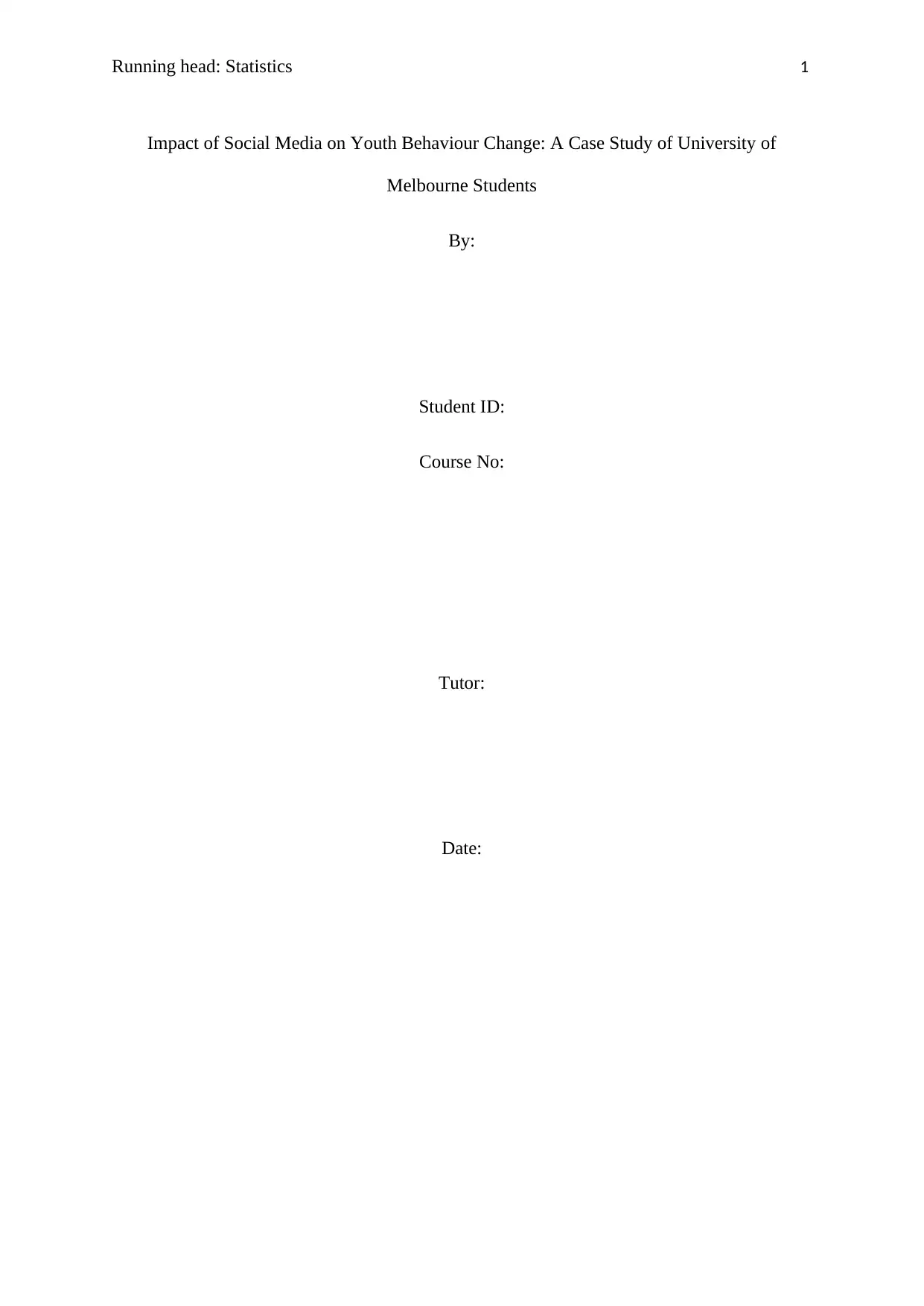
Running head: Statistics 1
Impact of Social Media on Youth Behaviour Change: A Case Study of University of
Melbourne Students
By:
Student ID:
Course No:
Tutor:
Date:
Impact of Social Media on Youth Behaviour Change: A Case Study of University of
Melbourne Students
By:
Student ID:
Course No:
Tutor:
Date:
Paraphrase This Document
Need a fresh take? Get an instant paraphrase of this document with our AI Paraphraser
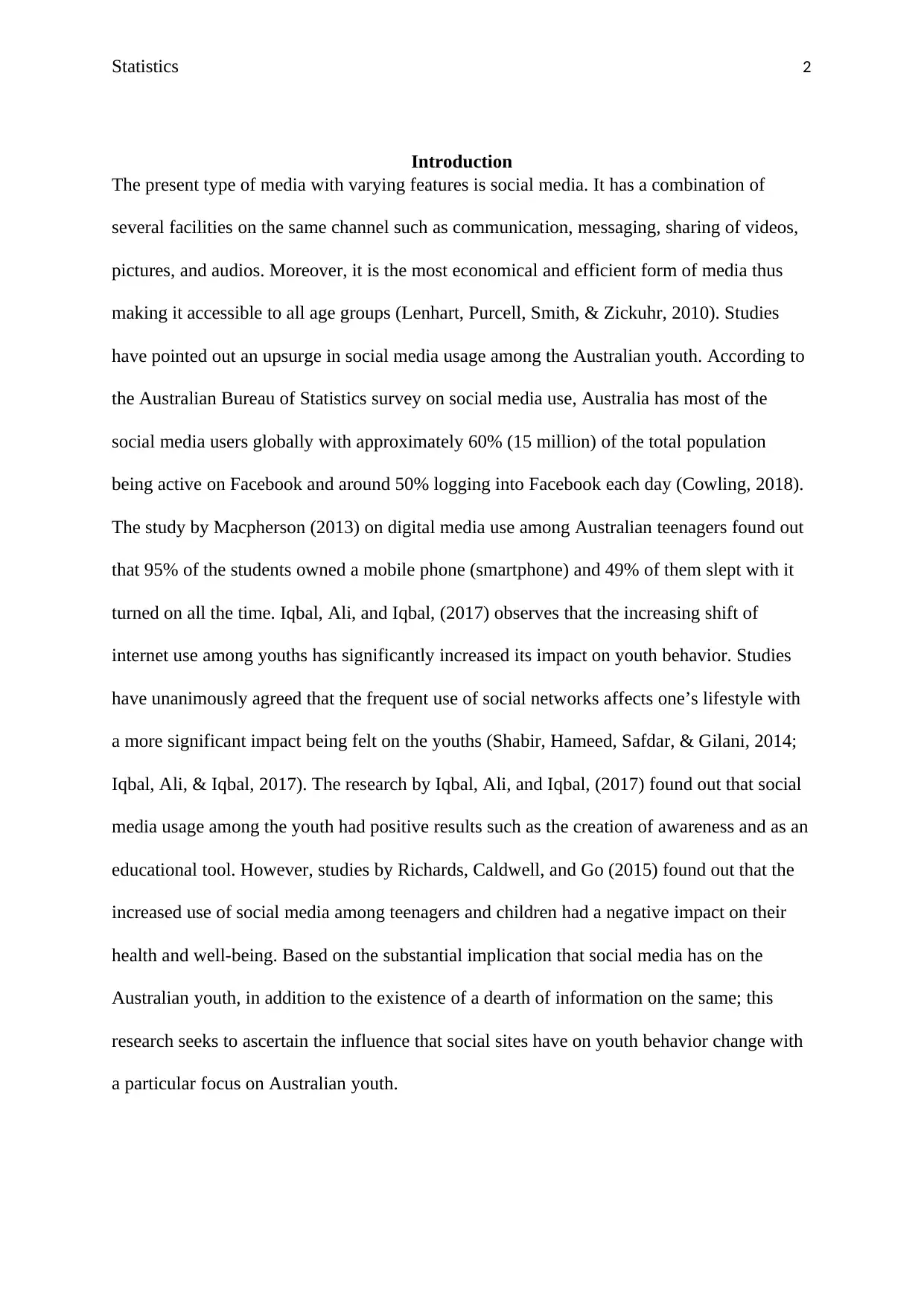
Statistics 2
Introduction
The present type of media with varying features is social media. It has a combination of
several facilities on the same channel such as communication, messaging, sharing of videos,
pictures, and audios. Moreover, it is the most economical and efficient form of media thus
making it accessible to all age groups (Lenhart, Purcell, Smith, & Zickuhr, 2010). Studies
have pointed out an upsurge in social media usage among the Australian youth. According to
the Australian Bureau of Statistics survey on social media use, Australia has most of the
social media users globally with approximately 60% (15 million) of the total population
being active on Facebook and around 50% logging into Facebook each day (Cowling, 2018).
The study by Macpherson (2013) on digital media use among Australian teenagers found out
that 95% of the students owned a mobile phone (smartphone) and 49% of them slept with it
turned on all the time. Iqbal, Ali, and Iqbal, (2017) observes that the increasing shift of
internet use among youths has significantly increased its impact on youth behavior. Studies
have unanimously agreed that the frequent use of social networks affects one’s lifestyle with
a more significant impact being felt on the youths (Shabir, Hameed, Safdar, & Gilani, 2014;
Iqbal, Ali, & Iqbal, 2017). The research by Iqbal, Ali, and Iqbal, (2017) found out that social
media usage among the youth had positive results such as the creation of awareness and as an
educational tool. However, studies by Richards, Caldwell, and Go (2015) found out that the
increased use of social media among teenagers and children had a negative impact on their
health and well-being. Based on the substantial implication that social media has on the
Australian youth, in addition to the existence of a dearth of information on the same; this
research seeks to ascertain the influence that social sites have on youth behavior change with
a particular focus on Australian youth.
Introduction
The present type of media with varying features is social media. It has a combination of
several facilities on the same channel such as communication, messaging, sharing of videos,
pictures, and audios. Moreover, it is the most economical and efficient form of media thus
making it accessible to all age groups (Lenhart, Purcell, Smith, & Zickuhr, 2010). Studies
have pointed out an upsurge in social media usage among the Australian youth. According to
the Australian Bureau of Statistics survey on social media use, Australia has most of the
social media users globally with approximately 60% (15 million) of the total population
being active on Facebook and around 50% logging into Facebook each day (Cowling, 2018).
The study by Macpherson (2013) on digital media use among Australian teenagers found out
that 95% of the students owned a mobile phone (smartphone) and 49% of them slept with it
turned on all the time. Iqbal, Ali, and Iqbal, (2017) observes that the increasing shift of
internet use among youths has significantly increased its impact on youth behavior. Studies
have unanimously agreed that the frequent use of social networks affects one’s lifestyle with
a more significant impact being felt on the youths (Shabir, Hameed, Safdar, & Gilani, 2014;
Iqbal, Ali, & Iqbal, 2017). The research by Iqbal, Ali, and Iqbal, (2017) found out that social
media usage among the youth had positive results such as the creation of awareness and as an
educational tool. However, studies by Richards, Caldwell, and Go (2015) found out that the
increased use of social media among teenagers and children had a negative impact on their
health and well-being. Based on the substantial implication that social media has on the
Australian youth, in addition to the existence of a dearth of information on the same; this
research seeks to ascertain the influence that social sites have on youth behavior change with
a particular focus on Australian youth.
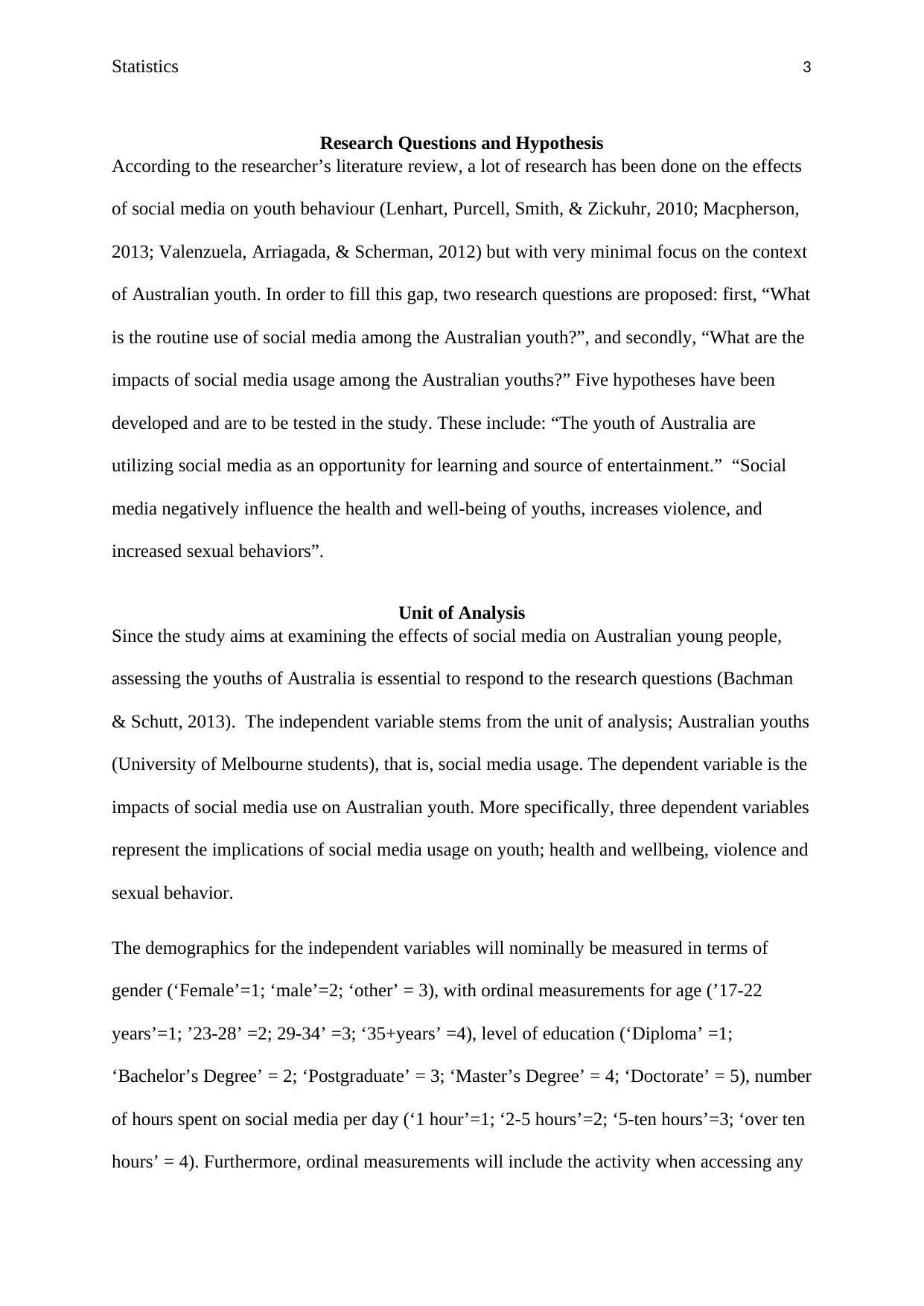
Statistics 3
Research Questions and Hypothesis
According to the researcher’s literature review, a lot of research has been done on the effects
of social media on youth behaviour (Lenhart, Purcell, Smith, & Zickuhr, 2010; Macpherson,
2013; Valenzuela, Arriagada, & Scherman, 2012) but with very minimal focus on the context
of Australian youth. In order to fill this gap, two research questions are proposed: first, “What
is the routine use of social media among the Australian youth?”, and secondly, “What are the
impacts of social media usage among the Australian youths?” Five hypotheses have been
developed and are to be tested in the study. These include: “The youth of Australia are
utilizing social media as an opportunity for learning and source of entertainment.” “Social
media negatively influence the health and well-being of youths, increases violence, and
increased sexual behaviors”.
Unit of Analysis
Since the study aims at examining the effects of social media on Australian young people,
assessing the youths of Australia is essential to respond to the research questions (Bachman
& Schutt, 2013). The independent variable stems from the unit of analysis; Australian youths
(University of Melbourne students), that is, social media usage. The dependent variable is the
impacts of social media use on Australian youth. More specifically, three dependent variables
represent the implications of social media usage on youth; health and wellbeing, violence and
sexual behavior.
The demographics for the independent variables will nominally be measured in terms of
gender (‘Female’=1; ‘male’=2; ‘other’ = 3), with ordinal measurements for age (’17-22
years’=1; ’23-28’ =2; 29-34’ =3; ‘35+years’ =4), level of education (‘Diploma’ =1;
‘Bachelor’s Degree’ = 2; ‘Postgraduate’ = 3; ‘Master’s Degree’ = 4; ‘Doctorate’ = 5), number
of hours spent on social media per day (‘1 hour’=1; ‘2-5 hours’=2; ‘5-ten hours’=3; ‘over ten
hours’ = 4). Furthermore, ordinal measurements will include the activity when accessing any
Research Questions and Hypothesis
According to the researcher’s literature review, a lot of research has been done on the effects
of social media on youth behaviour (Lenhart, Purcell, Smith, & Zickuhr, 2010; Macpherson,
2013; Valenzuela, Arriagada, & Scherman, 2012) but with very minimal focus on the context
of Australian youth. In order to fill this gap, two research questions are proposed: first, “What
is the routine use of social media among the Australian youth?”, and secondly, “What are the
impacts of social media usage among the Australian youths?” Five hypotheses have been
developed and are to be tested in the study. These include: “The youth of Australia are
utilizing social media as an opportunity for learning and source of entertainment.” “Social
media negatively influence the health and well-being of youths, increases violence, and
increased sexual behaviors”.
Unit of Analysis
Since the study aims at examining the effects of social media on Australian young people,
assessing the youths of Australia is essential to respond to the research questions (Bachman
& Schutt, 2013). The independent variable stems from the unit of analysis; Australian youths
(University of Melbourne students), that is, social media usage. The dependent variable is the
impacts of social media use on Australian youth. More specifically, three dependent variables
represent the implications of social media usage on youth; health and wellbeing, violence and
sexual behavior.
The demographics for the independent variables will nominally be measured in terms of
gender (‘Female’=1; ‘male’=2; ‘other’ = 3), with ordinal measurements for age (’17-22
years’=1; ’23-28’ =2; 29-34’ =3; ‘35+years’ =4), level of education (‘Diploma’ =1;
‘Bachelor’s Degree’ = 2; ‘Postgraduate’ = 3; ‘Master’s Degree’ = 4; ‘Doctorate’ = 5), number
of hours spent on social media per day (‘1 hour’=1; ‘2-5 hours’=2; ‘5-ten hours’=3; ‘over ten
hours’ = 4). Furthermore, ordinal measurements will include the activity when accessing any
⊘ This is a preview!⊘
Do you want full access?
Subscribe today to unlock all pages.

Trusted by 1+ million students worldwide
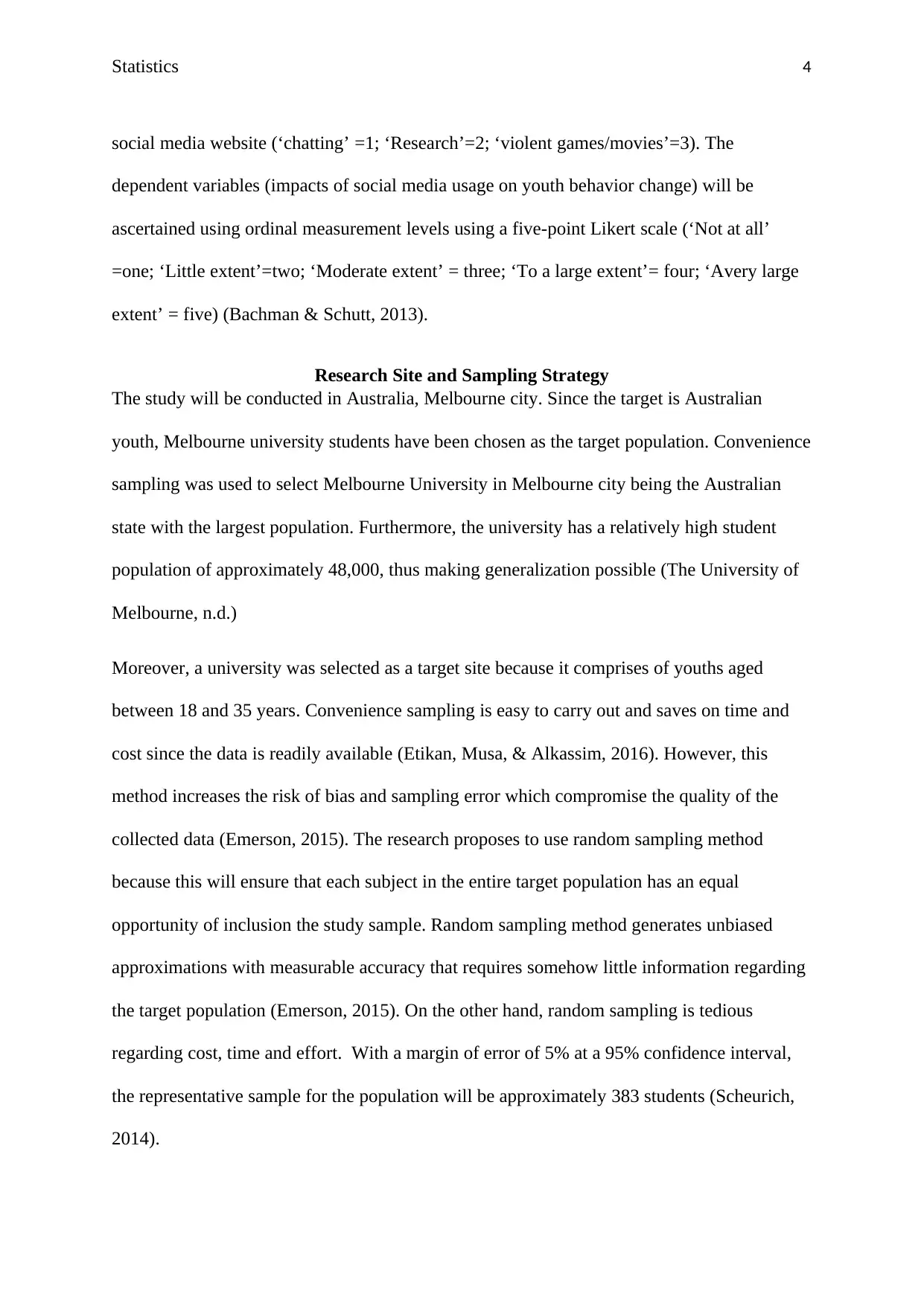
Statistics 4
social media website (‘chatting’ =1; ‘Research’=2; ‘violent games/movies’=3). The
dependent variables (impacts of social media usage on youth behavior change) will be
ascertained using ordinal measurement levels using a five-point Likert scale (‘Not at all’
=one; ‘Little extent’=two; ‘Moderate extent’ = three; ‘To a large extent’= four; ‘Avery large
extent’ = five) (Bachman & Schutt, 2013).
Research Site and Sampling Strategy
The study will be conducted in Australia, Melbourne city. Since the target is Australian
youth, Melbourne university students have been chosen as the target population. Convenience
sampling was used to select Melbourne University in Melbourne city being the Australian
state with the largest population. Furthermore, the university has a relatively high student
population of approximately 48,000, thus making generalization possible (The University of
Melbourne, n.d.)
Moreover, a university was selected as a target site because it comprises of youths aged
between 18 and 35 years. Convenience sampling is easy to carry out and saves on time and
cost since the data is readily available (Etikan, Musa, & Alkassim, 2016). However, this
method increases the risk of bias and sampling error which compromise the quality of the
collected data (Emerson, 2015). The research proposes to use random sampling method
because this will ensure that each subject in the entire target population has an equal
opportunity of inclusion the study sample. Random sampling method generates unbiased
approximations with measurable accuracy that requires somehow little information regarding
the target population (Emerson, 2015). On the other hand, random sampling is tedious
regarding cost, time and effort. With a margin of error of 5% at a 95% confidence interval,
the representative sample for the population will be approximately 383 students (Scheurich,
2014).
social media website (‘chatting’ =1; ‘Research’=2; ‘violent games/movies’=3). The
dependent variables (impacts of social media usage on youth behavior change) will be
ascertained using ordinal measurement levels using a five-point Likert scale (‘Not at all’
=one; ‘Little extent’=two; ‘Moderate extent’ = three; ‘To a large extent’= four; ‘Avery large
extent’ = five) (Bachman & Schutt, 2013).
Research Site and Sampling Strategy
The study will be conducted in Australia, Melbourne city. Since the target is Australian
youth, Melbourne university students have been chosen as the target population. Convenience
sampling was used to select Melbourne University in Melbourne city being the Australian
state with the largest population. Furthermore, the university has a relatively high student
population of approximately 48,000, thus making generalization possible (The University of
Melbourne, n.d.)
Moreover, a university was selected as a target site because it comprises of youths aged
between 18 and 35 years. Convenience sampling is easy to carry out and saves on time and
cost since the data is readily available (Etikan, Musa, & Alkassim, 2016). However, this
method increases the risk of bias and sampling error which compromise the quality of the
collected data (Emerson, 2015). The research proposes to use random sampling method
because this will ensure that each subject in the entire target population has an equal
opportunity of inclusion the study sample. Random sampling method generates unbiased
approximations with measurable accuracy that requires somehow little information regarding
the target population (Emerson, 2015). On the other hand, random sampling is tedious
regarding cost, time and effort. With a margin of error of 5% at a 95% confidence interval,
the representative sample for the population will be approximately 383 students (Scheurich,
2014).
Paraphrase This Document
Need a fresh take? Get an instant paraphrase of this document with our AI Paraphraser
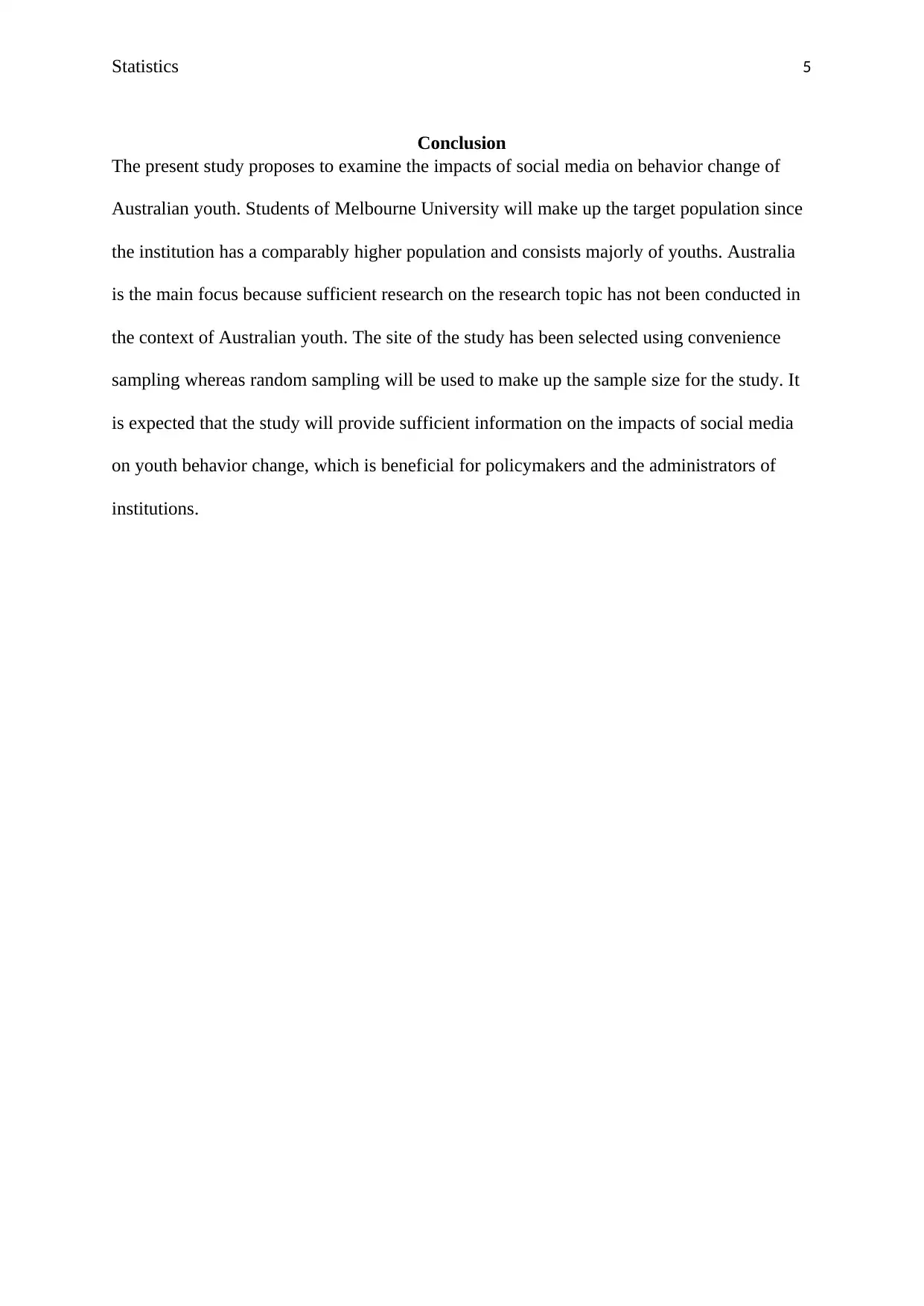
Statistics 5
Conclusion
The present study proposes to examine the impacts of social media on behavior change of
Australian youth. Students of Melbourne University will make up the target population since
the institution has a comparably higher population and consists majorly of youths. Australia
is the main focus because sufficient research on the research topic has not been conducted in
the context of Australian youth. The site of the study has been selected using convenience
sampling whereas random sampling will be used to make up the sample size for the study. It
is expected that the study will provide sufficient information on the impacts of social media
on youth behavior change, which is beneficial for policymakers and the administrators of
institutions.
Conclusion
The present study proposes to examine the impacts of social media on behavior change of
Australian youth. Students of Melbourne University will make up the target population since
the institution has a comparably higher population and consists majorly of youths. Australia
is the main focus because sufficient research on the research topic has not been conducted in
the context of Australian youth. The site of the study has been selected using convenience
sampling whereas random sampling will be used to make up the sample size for the study. It
is expected that the study will provide sufficient information on the impacts of social media
on youth behavior change, which is beneficial for policymakers and the administrators of
institutions.
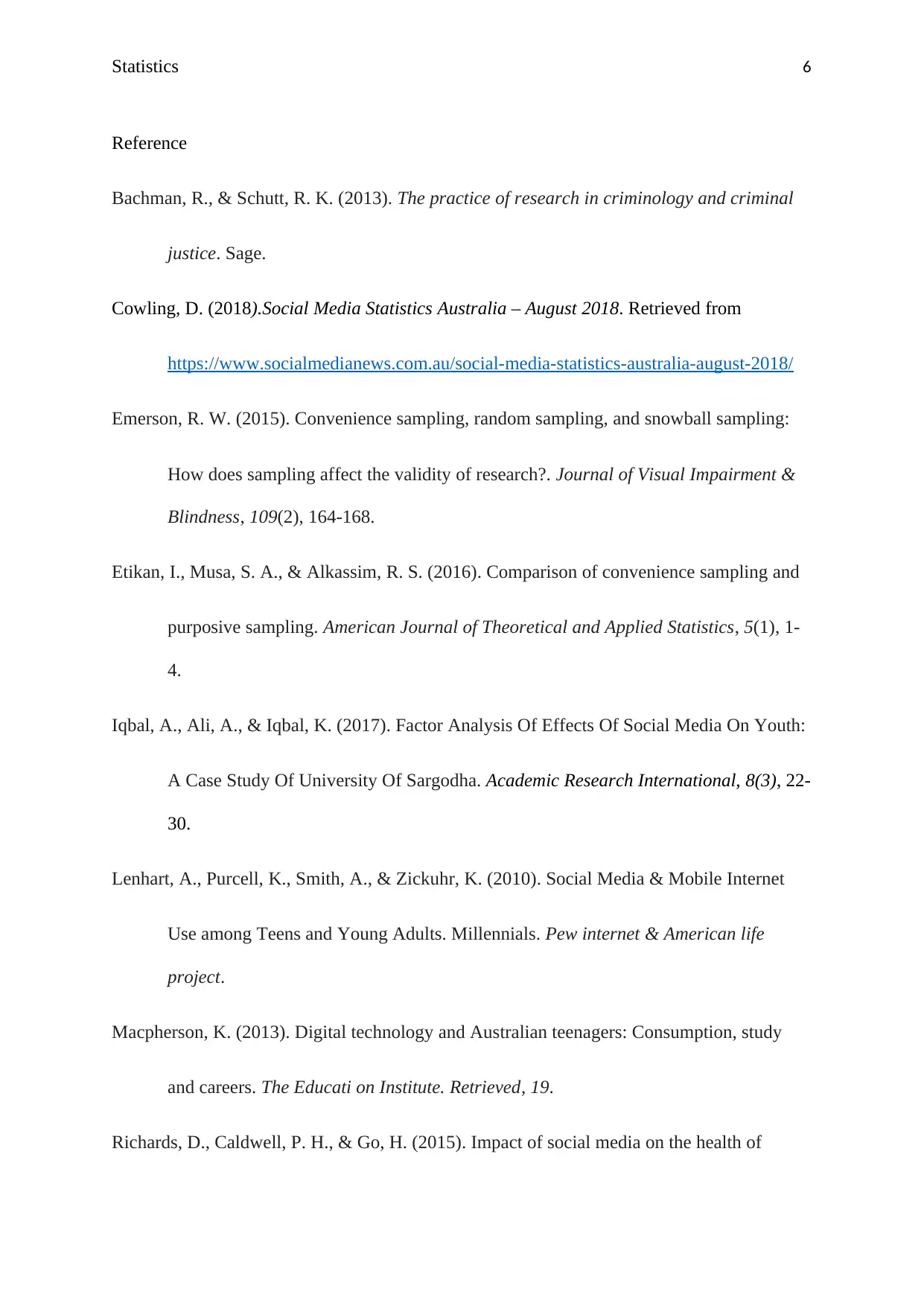
Statistics 6
Reference
Bachman, R., & Schutt, R. K. (2013). The practice of research in criminology and criminal
justice. Sage.
Cowling, D. (2018).Social Media Statistics Australia – August 2018. Retrieved from
https://www.socialmedianews.com.au/social-media-statistics-australia-august-2018/
Emerson, R. W. (2015). Convenience sampling, random sampling, and snowball sampling:
How does sampling affect the validity of research?. Journal of Visual Impairment &
Blindness, 109(2), 164-168.
Etikan, I., Musa, S. A., & Alkassim, R. S. (2016). Comparison of convenience sampling and
purposive sampling. American Journal of Theoretical and Applied Statistics, 5(1), 1-
4.
Iqbal, A., Ali, A., & Iqbal, K. (2017). Factor Analysis Of Effects Of Social Media On Youth:
A Case Study Of University Of Sargodha. Academic Research International, 8(3), 22-
30.
Lenhart, A., Purcell, K., Smith, A., & Zickuhr, K. (2010). Social Media & Mobile Internet
Use among Teens and Young Adults. Millennials. Pew internet & American life
project.
Macpherson, K. (2013). Digital technology and Australian teenagers: Consumption, study
and careers. The Educati on Institute. Retrieved, 19.
Richards, D., Caldwell, P. H., & Go, H. (2015). Impact of social media on the health of
Reference
Bachman, R., & Schutt, R. K. (2013). The practice of research in criminology and criminal
justice. Sage.
Cowling, D. (2018).Social Media Statistics Australia – August 2018. Retrieved from
https://www.socialmedianews.com.au/social-media-statistics-australia-august-2018/
Emerson, R. W. (2015). Convenience sampling, random sampling, and snowball sampling:
How does sampling affect the validity of research?. Journal of Visual Impairment &
Blindness, 109(2), 164-168.
Etikan, I., Musa, S. A., & Alkassim, R. S. (2016). Comparison of convenience sampling and
purposive sampling. American Journal of Theoretical and Applied Statistics, 5(1), 1-
4.
Iqbal, A., Ali, A., & Iqbal, K. (2017). Factor Analysis Of Effects Of Social Media On Youth:
A Case Study Of University Of Sargodha. Academic Research International, 8(3), 22-
30.
Lenhart, A., Purcell, K., Smith, A., & Zickuhr, K. (2010). Social Media & Mobile Internet
Use among Teens and Young Adults. Millennials. Pew internet & American life
project.
Macpherson, K. (2013). Digital technology and Australian teenagers: Consumption, study
and careers. The Educati on Institute. Retrieved, 19.
Richards, D., Caldwell, P. H., & Go, H. (2015). Impact of social media on the health of
⊘ This is a preview!⊘
Do you want full access?
Subscribe today to unlock all pages.

Trusted by 1+ million students worldwide
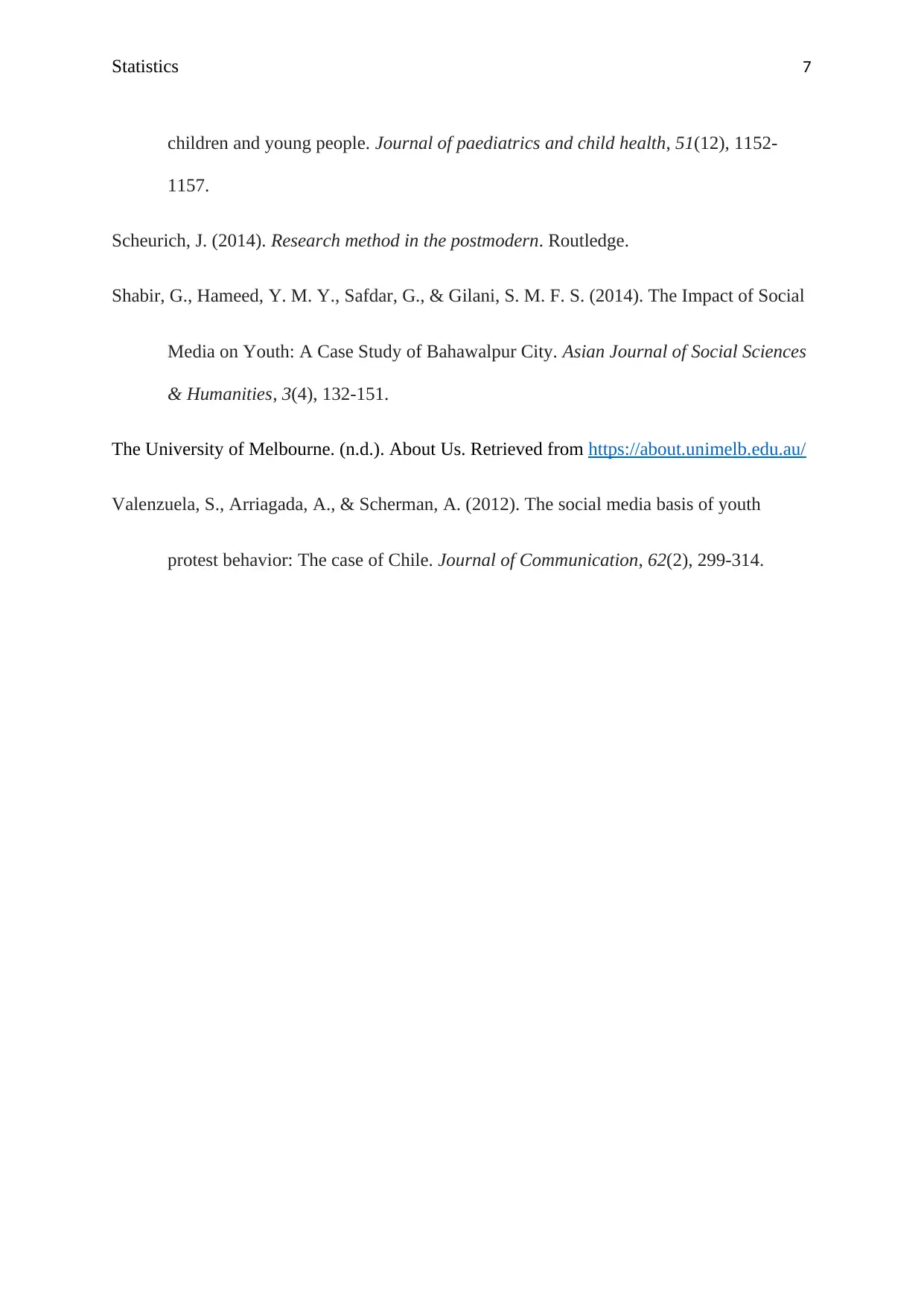
Statistics 7
children and young people. Journal of paediatrics and child health, 51(12), 1152-
1157.
Scheurich, J. (2014). Research method in the postmodern. Routledge.
Shabir, G., Hameed, Y. M. Y., Safdar, G., & Gilani, S. M. F. S. (2014). The Impact of Social
Media on Youth: A Case Study of Bahawalpur City. Asian Journal of Social Sciences
& Humanities, 3(4), 132-151.
The University of Melbourne. (n.d.). About Us. Retrieved from https://about.unimelb.edu.au/
Valenzuela, S., Arriagada, A., & Scherman, A. (2012). The social media basis of youth
protest behavior: The case of Chile. Journal of Communication, 62(2), 299-314.
children and young people. Journal of paediatrics and child health, 51(12), 1152-
1157.
Scheurich, J. (2014). Research method in the postmodern. Routledge.
Shabir, G., Hameed, Y. M. Y., Safdar, G., & Gilani, S. M. F. S. (2014). The Impact of Social
Media on Youth: A Case Study of Bahawalpur City. Asian Journal of Social Sciences
& Humanities, 3(4), 132-151.
The University of Melbourne. (n.d.). About Us. Retrieved from https://about.unimelb.edu.au/
Valenzuela, S., Arriagada, A., & Scherman, A. (2012). The social media basis of youth
protest behavior: The case of Chile. Journal of Communication, 62(2), 299-314.
1 out of 7
Related Documents
Your All-in-One AI-Powered Toolkit for Academic Success.
+13062052269
info@desklib.com
Available 24*7 on WhatsApp / Email
![[object Object]](/_next/static/media/star-bottom.7253800d.svg)
Unlock your academic potential
Copyright © 2020–2025 A2Z Services. All Rights Reserved. Developed and managed by ZUCOL.




